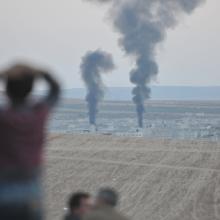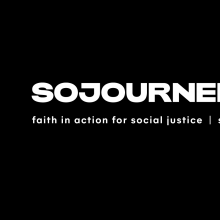pacifism
REVELATION IS AN intimidating book of the Bible to understand, let alone apply to everyday life. Dense with symbolic imagery and metaphors, it has been subject to innumerable interpretations and far-flung theories. But what are we to make of startling moments in the text, like when Jesus regurgitates a sword or John eats a scroll? In Upside-Down Apocalypse: Grounding Revelation in the Gospel of Peace, author Jeremy Duncan walks readers through Revelation by drawing parallels between the genres and figures of speech of John’s day and ours, lending clarity to how John’s apocalypse is deeply steeped in Jewish literary tradition and Roman culture. When we ignore this context, we miss the point of the final book of the New Testament: Revelation is not the wrathful reckoning of a conquering king; rather, as Duncan writes, it’s a testament to “how the Prince of Peace turns violence on its head once and for all.”
With each chapter, Duncan decenters “chrono-centric” approaches to Revelation, encouraging readers to avoid reading the text as “a story about me and my world and my time exclusively.” As the perfect, timeless witness of God, Jesus must be the guiding principle by which we understand all of scripture. Only then can we appreciate how God’s kingdom in Revelation contrasts with earthly kingdoms fueled by oppression. “[E]very time you awaken to how empire is trying to steal your imagination and make you believe in violence,” Duncan writes, “you have rightly interpreted Revelation regardless of the time period in which you awake.” Revelation asks us to watch for injustice, wherever and whenever it appears.
Rustin, who died in 1987, is best known for helping Rev. Martin Luther King Jr. implement Gandhian tactics of nonviolence and for the key role he played organizing the 1963 March on Washington and the Southern Christian Leadership Conference — two key components of the civil rights movement.
Less well-known are the particularities of Rustin's faith, including his deep roots in the Quaker and African Methodist Episcopal churches which drove his activism. Those two faith traditions, marked by silence and singing, respectively, echoed throughout Rustin’s life and work.
WE LONG FOR new beginnings, a restart, to go back in time to correct our mistakes or dodge the harm someone has done to us. But those former lives are inaccessible to us. All we have is this life now. Here we are in the middle: after the beginning and before the end. Usually we associate “middles” with “stuckness”—not the excitement of the new and not the relief of an end but locked in between. For example, the morass that prompts a midlife crisis, that languorous experience of the middle of life that leads to the purchase of a motorcycle.
In the church calendar, we’re in the season called “ordinary time,” a long stretch of weeks between Pentecost and Advent. These are the middle months where the scriptures plop us into the middle of stories. And that is where we find Jesus. The incarnation is an act of God in the middle of Israel’s story: not the beginning, not the conclusion, but God-with-us in the middle. This season of unceasing tedium has also been taken up into the life of God. Perhaps we could describe the incarnation as the midlife crisis of God?
Jesus is the one who has been with us from before the beginning, who has witnessed the groaning of all creation, the births and deaths and the life in between—and comes to us now, where we are, in our midlife, with our regrets and unfulfilled dreams, and guides us as we wander into the ordinary goodness of life.
When new people come to our Mennonite church in North Carolina, whether from other traditions or from no church background, I imagine they are stirred by our views on peace and violence. The strangest part of our religious life is not that we believe that dead people come back to life, or that we try to live like a peasant we believe was God — it is our disposition toward military service.
Could the United States ever do something so heinous that it would become morally necessary for a foreign military to drop bombs on my house? This is the question that was running through my mind on November 11, 2018, when Montclair Presbyterian Church in Oakland, Calif. —a congregation of around 250 souls who were kind enough to invite me to be their pastor five years ago — voted overwhelmingly to embrace pacifism by declaring itself to be a peace church.
The two major streams of Christian engagement on war are pacifism and just war theory, which comes out of Catholic social teaching. The pacifist response to Syria strikes is clearly opposed. As for the just war analysis, it takes a little explaining, but reaches the same conclusion.

thaikrit / Shutterstock
THIS SPRING, the Vatican hosted a historic convocation focused on what Pope Francis called “the active witness of nonviolence as a ‘weapon’ to achieve peace.”
Eighty participants from around the world told striking, at times heroic, stories of nonviolent peacemaking at the Rome gathering, convened by the Catholic peace movement Pax Christi International and the Vatican’s justice and peace office.
Many of them arrived directly from situations where they are mediating between violent factions using pragmatic nonviolence fueled by Christian faith—as in Uganda, Iraq, Colombia, and Mexico. Others are engaged in nonviolent peacebuilding in regions recovering from traumatic violence—as in Sri Lanka, Kenya, and the Philippines. Some are active in unarmed civilian accompaniment, shielding people under threat of violence—as in Palestine, Syria, and South Sudan. Theologians, ethicists, and international policy negotiators contributed broader context to the situational experiences.
The conversation focused on four key questions: 1) What can we learn from experiences of nonviolence as a spiritual commitment of faith and a practical strategy in violent situations across cultural contexts? 2) How do recent experiences of active nonviolence help illuminate Jesus’ way of nonviolence and engaging conflict? 3) What are the theological developments on just peace and how do they build on the scriptures and the trajectory of Catholic social thought? 4) What are key elements of an ethical framework for engaging acute conflict and addressing the “responsibility to protect” rooted in the theology and practices of nonviolent conflict transformation, nonviolent intervention, and just peace?
The convocation concluded with an astonishing document, presented to Pope Francis, titled “An appeal to the Catholic Church to recommit to the centrality of gospel nonviolence.” Recommendations included a request for a papal encyclical calling Christians to return to their fundamental vocation of nonviolent peacemaking. That means rejecting just war theory as the “settled teaching” of the church and replacing it with Jesus’ life and teaching as the foremost guide.

Photo via Albert H. Teich / Shutterstock
And it's an Old Testament law.
Bob Lonsberry of WHAM 1180 AM radio asked the Republican front-runner, "Is there a favorite Bible verse or Bible story that has informed your thinking or your character through life?"

Photo via Drop of Light / Shutterstock.com
For his final State of the Union address, President Obama delivered a characteristically eloquent and passionate speech. He issued a heartfelt call for unity and cooperation in a country whose political climate is just a few notches short of civil war. He asked us to consider how we might move forward as one nation, affirming our highest ideals rather than the hateful rhetoric of would-be despots.
Obama’s final State of the Union was in many ways a masterpiece of American political theater. He reminded us of the best of our tradition, calling us to live up to our history of welcoming the outsider and being a land of opportunity for all people. Despite the fact that this canonical history is to a great degree aspirational rather than actual, I was at many points uplifted to hear the president invite us to live into the more beautiful aspects of the American Dream.

Killing from the Inside Out / Amazon
DAYS AFTER 9/11, a just war philosopher and I were interviewed on Christian radio. I’m a pacifist who served on peace teams in Nicaragua and Iraq. My co-interviewee called for waging war on “terrorists” because we must kill our enemies while loving them. My plea to listen to Jesus and victims of war was scorned.
Two compelling recent challenges to Christian justifications for war are Robert Emmet Meagher’s Killing from the Inside Out: Moral Injury and Just War and Stan Goff’s Borderline: Reflections on War, Sex, and Church.
Meagher, a humanities scholar, incorporates listening to veterans of war into his work. Goff writes as someone who was a soldier before being transformed by Jesus.
Three issues in both books—just war, masculine sexual violence, and moral injury—resonate with my peace team encounters with war. Through very different approaches, Meagher and Goff offer the best reflection on these concerns that I’ve seen; both rightly implicate the church.
First, just war has a sordid rather than sanctifying history. Meagher’s survey of ancient literature, scripture, and Christian history reveals its legacy as antithetical to Jesus’ teaching: “Since the time of Constantine ... just war doctrine has served to license and legitimize state and ecclesiastical violence and to draw a convenient, if imaginary, line between killing and murder.”

Image via Orlok / Shutterstock.com
I wonder if Pope Francis knows that he’s being used to justify bombing Syria.
After an all-day debate on Dec. 2, the House of Commons authorized the British government to begin bombing ISIS in Syria. Hours later, RAF Tornadoes attacked an oil field in eastern Syria.
During the debate, Caroline Spelman, the member of parliament who represents the Church of England in the Commons, noted that, “The Archbishop of Canterbury made it clear that, in his view, force might be necessary to keep the refugees safe.”
Then, citing Pope Francis, she said, “‘Where aggression is unjust, aggression is licit against the aggressor.’ These are views which I share, which is why I will support the motion.”

Image via veleknez/Shutterstock
Yoder became a superstar at the Anabaptist Mennonite Biblical Seminary in Elkhart, Ind., where he taught for 24 years, respected and admired by fellow church members and Christians who were not Mennonite. Yet, at the same time, he was preying on women, many of them his students. A report has revealed a range of sexual offenses, starting in the mid-1970s, as well as the church’s efforts to keep them quiet.
A couple of folks I really respect – Kate Gould of Friends Committee on National Legislation (aka, the Quaker Lobby), and Jim Wallis of Sojourners – were recently on the O’Reilly Factor. For those of you who don’t watch cable news, this is a television program where Bill O’Reilly basically screams at people and incites hatred of anything non-white, non-rich, and non-Republican. I normally don’t watch the show. But when I heard that Kate and Jim were going to be talking, I tuned in.
I knew almost immediately this wasn’t going to be good. It’s Bill’s program, so he gets to frame the question. Here’s what he asks: Do Christian pacifists have a solution for stopping ISIS?
It’s the wrong question.
What good would it do for three kayaks, three canoes, and a rubber dinghy to paddle into the path of a Pakistani steamship? For a tiny fishing boat with unarmed, praying Americans aboard to sail toward an American battleship threatening Nicaragua? For an 80-year-old lady in a wheelchair to stop in front of advancing Filipino tanks? Or for nonviolent protesters to defy the communist rulers of the Soviet Empire?
Soviet communism collapsed. The tanks stopped and a nonviolent revolution succeeded. The American battleship left and the threat of invasion faded. And the U.S. shipment of arms to Pakistan stopped.
Those are just a few of the many dramatic successes of nonviolent confrontation in the last several decades. Everyone, of course, knows how Mahatma Gandhi’s nonviolent revolution eventually defeated the British Empire and – as the powerful film Selma now reminds us – Martin Luther King Jr.’s peaceful civil rights crusade changed American history. There have been scores upon scores of instances of nonviolent victories over dictatorship and oppression in the last 50-plus years. In fact, Dr. Gene Sharp, the foremost scholar of nonviolence today, has said that the later 20th century saw a remarkable expansion of the substitution of nonviolent struggle for violence. More recent scholarship has not only confirmed Sharp’s comment; it has also shown that nonviolent revolutions against injustice and dictatorship are actually more successful than violent campaigns.
Miles of yellow wheat bend; their leaves / rustle away and wait for the sun and wind.
—From “A Farewell, Age Ten”
We wondered what our walk should mean, / taking that un-march quietly; / the sun stared at our signs—"Thou shalt not kill.”
—From “Peace Walk”
WILLIAM STAFFORD was a poet of the land and a conscience that fanned out over the land. Born in Hutchinson, Kan., 100 years ago—on Jan. 17, 1914—it was perhaps his early intimacy with space and sky that opened him to the mystery of human frailty.
At age 6, he saw two black students at his school being taunted by whites. He stood with them.
Another mystery: He who personifies the term national poet is largely unknown in his nation. Four new books (in his 79 years, Stafford published more than 50 books) published to coincide with his centennial might help redress this situation. Ask Me (Graywolf Press), from which the above excerpts are taken, brings to readers 100 “essential” Stafford poems dealing with his pacifism, his family, Native Americans, and the landscapes of his native Kansas and his adopted Oregon, where many centenary events are scheduled to take place.
Week after bloody week, the chart of killings lengthens. And in Afghanistan, while war rages, a million children are estimated to suffer from acute malnourishment as the country faces a worsening hunger crisis.
Around this Martin Luther King, Jr. Day, we can and should remember the dream Dr. King announced before the Lincoln Memorial, the dream he did so much to accomplish, remembering his call (as the King Center asks) for nonviolent solutions to desperate concerns of discrimination and inequality within the U.S. But we shouldn't let ourselves forget the full extent of Dr. King's vision, the urgent tasks he urgently set us to fulfill on his behalf, so many of them left unfinished nearly 46 years after he was taken from us.
Even as the world’s powers grasped for a last-minute resolution to the crisis in Syria, it remained an open question whether any amount of diplomacy could prevent the conflict from claiming at least one more victim: the classic Christian teaching known as the “just war” tradition.
The central problem is not that the just war doctrine is being dismissed or condemned, but that it is loved too much. Indeed, both sides in the debate over punishing the Syrian regime for using chemical weapons are citing just war theory, but are reaching diametrically opposed conclusions.










